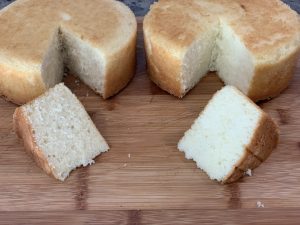Let's Bake
Cake Flour vs. All-Purpose Flour
Cake Flour vs. All-Purpose Flour
Is there a difference?
Have you ever wondered if there is a difference between cake flour and all-purpose flour?
If you love baking as much as I do, you’ve probably wondered why a recipe calls for cake flour vs. all-purpose flour.
I’m going to explain why cake flour and all-purpose flour is different. I’ll also share some tips on what you can do if you’re in a pinch and only have one or the other on hand.
All Flour is Not Created Equally

You can make cakes and baked goods with cake flour or all-purpose flour, but they really aren’t created equal.
All-purpose flour is probably one of the most common types of flour people have in their pantry.
Just about any supermarket carries all-purpose flour. It’s not always as easy to find cake flour.
The reason all-purpose flour is because it’s the most commonly used type of flour for cakes, cookies, pie crust, biscuits, pizza dough, and breads.
Types of Flour
There are many types of flour and each type of flour is useful in different applications. Most of the most common types of flour used are:
- Cake Flour
- Pastry Flour
- All-Purpose Flour
- Bread Flour
- Semolina Flour
Different types of flour listed above are derived from wheat. Cake flour is made from soft wheat, whereas bread flour is used from hard wheat. I won’t get into the entire process of how flour is made, but I will explain why there is a difference between cake flour and all-purpose flour.
First, cake flour has a lower protein content than all-purpose flour. Cake flour has a protein content of approximately 6-8%, whereas all-purpose flour has a content of 10-12% protein content. There are many recipes that you can interchange cake flour vs. all-purpose flour, but the end result of your baked product may come out slightly different.
Protein Content in Flour
| Flour Type | Protein Content |
|---|---|
| Cake flour | 6-8% |
| Pastry flour | 8-10% |
| All-Purpose flour | 10-12% |
| Bread flour | 12-15% |
| Semolina | 13% |
NOTE: Protein content in flour is approximate and can vary by brand.
Name brands of flour that I use most often are King Arthur, General Mills, Pillsbury, and Swans Down.
Almond Flour and Coconut Flour are not made from wheat. These are essentially nuts ground into a fine flour-like consistency. Since nut flours are not derived from wheat, they’re great for special dietary needs such as Keto or Gluten-Free diets. Nut flour is also great for making French macarons, short dough, and other specialty items.
Flour that has a lower protein content is usually used for cakes, pastries, and more delicate baked items. Higher protein in flour is used for breads, pizza, and bagels that need the extra protein to help its structure when gluten strands are formed in the mixing process.
Another way to think of lower protein content in flour is that extra leavening is usually required. Leavening is often in the form of baking powder or baking soda. This helps the baked product expand outward. Higher content flour usually does not require extra leavening and the product expands upwards and has lots of structure like a nice crusty bread.
Cake Flour vs. All-Purpose Flour
Not all cake recipes call for cake flour. Some cakes, such as pound cake usually have all-purpose flour in the recipe. If you use cake flour vs. all-purpose flour in a cake recipe, you may notice a more delicate crumb.
If you use all-purpose flour in a pound cake, you may notice the crumb is less crumbly and more of a dense/tight type crumb.
How to Make a Cake Flour Substitute
So, what do you do if you have a recipe that calls for cake flour but you only have all-purpose flour in your pantry? Don’t stress, you can make a substitute for cake flour if you’re in a pinch.
CAKE FLOUR SUBSTITUTE
– For each cup of All-purpose flour – remove 2 tablespoons
– Add 2 tablespoons cornstarch
– Sift ingredients together and use according to recipe
Conversely, you can make an all-purpose flour by adding cake flour to it but it may not yield the same result.
Test Recipe
I wanted to test out the difference of my pound cake recipe using cake flour and all-purpose flour. The difference in the cakes I made below were barely discernible.

Testing a recipe is a great way to see how flour functions in a recipe. Both of the cakes in the photo were equally as tasty. To be honest, if it was not for the different flavors I added to each batch of cake batter, I would have had a hard time telling the difference of cake flour vs. all-purpose flour.
That being said, I wouldn’t recommend using cake flour to make pizza dough. However, you can interchange cake flour vs. all-purpose flour in some recipes. Test out your recipe in a small batch to see how it comes out or try the recipe above for a great substitute.
I hope this post is helpful to you.
Try my recipe for pound cake and let me know which worked best for you (cake flour vs. all-purpose flour).
Happy Baking!
